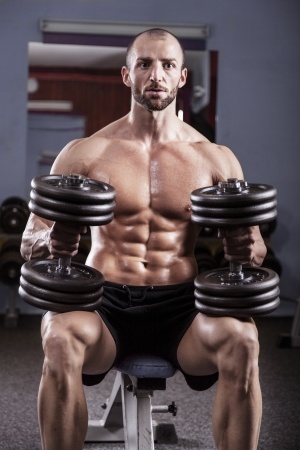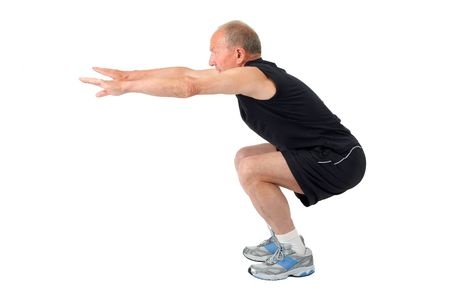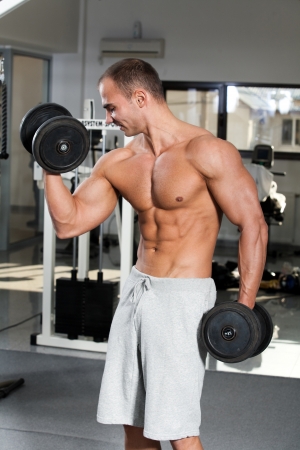

- HGH Deficiency
- So you took a look at yourself in a mirror recently and your heart sank by what you saw.
- Can Human Growth Hormones Really Reverse the Signs of Aging
- We hear about HGH or human growth hormone supplements far more often than we did just a few years ago.
- HGH Benefits for Men
- There are several benefits that males can derive from HGH use, although these are mostly off-label.
- How to Handle an HGH Deficiency in Adults?
- our physician tells you that you have a human growth hormone deficiency or HGH deficiency – now what? What does this mean?
- HGH Use for Bodybuilding
- Human growth hormone (HGH) is considered highly essential for the health and wellbeing of an average person.
- GenF20Plus Double Blind Clinical Study Shows Results That are Promising
- The market is full of unproven HGH products, but only the manufacturer of Genf20 Plus has taken the time to conduct a double blind clinical study.
Slow Down Aging with Intensive Exercises
The search for that elusive fountain of youth is seemingly a
never-ending one. People interested in maintaining
youthful
appearance have been exploiting diverse options they believe can
help in this regard. However, one of the best ways available to roll
back the years is exercise. What makes this option particularly
interesting is that you do not necessarily need to part with
hundreds or thousands of dollars as you would for some anti-aging
programs or procedures. Now,
aging slowdown is only one of a
truck-load of benefits on offer. And when talking about exercises,
high-intensity training can especially be helpful in the search for
what can make you age gracefully.

Why you need to take exercise more seriously
Muscle mass is one of those things that suffer as you grow older. The reason for this is not unconnected with the drop in the levels of hormones in the body, especially that of growth hormone. This decline becomes more considerable after the age of 30 and worsens in subsequent years. Loss of muscle mass is estimated around 8 percent for every 10 years after the age of 40. Yet, you need muscle mass for healthy living as you get older. Exercise is undoubtedly the best way that is known by which you can build muscles and this can go a long way in enhancing longevity.
Exercise helps to guard against health issues that usually set in with the aging process. It enhances flexibility which goes a long way in improving your range of motion, thus helping you to be more active. Interestingly, exercise also helps to boost your endurance by improving maximum heart rate – which is said to decline by around one beat a minute each – as well as the amount of blood pumped by the heart. It can guard against mental deterioration and mood swings. Research has revealed that exercise can slow brain aging by as many as 10 years!
Appreciating intensive exercises
You stand to benefit whenever you exercise, regardless of what routines you engage in. Research has shown that physical activity or training fires up mitochondrial biogenesis, which usually suffers as people grow older. Mitochondria are the powerhouse of body cells providing energy needed for vital metabolic functions. Improving mitochondrial activity helps to eliminate free radicals in the body that are capable of doing harm to cells and causing serious health issues. Poorly-functioning mitochondria can give rise to diverse health issues, including obesity and insulin resistance, in addition to speeding up the aging clock.
Exercising is good, but, when done wrongly, it can be potentially counterproductive. When talking about exercising for the purpose of fighting aging, high-intensity interval training (what some call Peak Fitness) is arguably the best to consider. This aims to balance intensity and timing for the best of results. An exercise routine following this pattern starts with a warm-up of about three minutes which is followed by an intense workout lasting 25-35 seconds. You then use about 90 seconds to recover before repeating the process all over. This may be done for several times.
You might have thought a high-intensity interval training to be too demanding from the name. But, as described, you will agree that it is not as scary as it sounds. The workout method is such that older individuals should find it easy to cope. And you may be surprised to learn that intensive exercises done this way are estimated to ramp up human growth hormone (HGH) production by as high as 771 percent! This is made possible through stimulation of what are called fast muscle fibers. These workouts, which take about 20 minutes to complete (including warm-up and recovery times), can be done only three times a week to see noticeable results in your effort to slow your aging clock. Almost all forms of exercises will do for this purpose. All that is needed is for you to push yourself hard, but not necessarily to the extreme.
Studies have shown that intensive exercises can help older people slow muscle aging at the cellular level. Athletic elderly people tend to have younger and stronger muscle tissues than others of similar age who do not maintain an active lifestyle. High-intensity workouts prevent shortening of telomeres, which are DNA strands at the ends of chromosomes. Cell division and replication cause telomeres to shorten over time. But these cells can die off when the telomeres get too short leading to aging.
Some exercises that can help you age gracefully
Strength and stamina building exercises are arguably the most effective for those looking to slow down aging. The reason is that these sorts of workouts impact on virtually all major muscle groups in your body. They help you build muscle mass and, believe it or not, research has shown that the number of years you live is related to how much muscles you have. Below are some exercise routines you can consider to maintain younger look, especially when they are of high intensity and done with intervals for recovery.
Weightlifting
This is what readily comes to mind when strength training is mentioned, even though there are other forms. Studies have shown it both helps to build muscle mass and slow weight gain. Use around three seconds to lift an appropriate weight into place and another three seconds to go back to starting position; you should hold each position for one second. It is advised to start with a weight you can manage to lift just about eight times. To build strength, you can add more weights once you are able to do two sets of about 15 repetitions with a specific weight.
Squatting
 People looking to slow aging can also benefit from squatting
exercises which enhance hip flexibility and strengthens hip flexors and
quadriceps. The routine reduces risk of falls by improving your overall
balance and stability. There are diverse types to choose from according
to your level of fitness. One of this is partial or half squat. You
begin this by standing, probably with your back slightly against a wall,
and legs kept apart a little wider than shoulder width. You then bend
your knees until the knee caps are in line with your toes. If you are
strong enough, you may bend until you are in seating position - as if in
an imaginary chair. Hold the position for some seconds. Do sets of about
15 repetitions. You may make the routine a bit more challenging later
on, such as by holding dumbbells in your hands.
People looking to slow aging can also benefit from squatting
exercises which enhance hip flexibility and strengthens hip flexors and
quadriceps. The routine reduces risk of falls by improving your overall
balance and stability. There are diverse types to choose from according
to your level of fitness. One of this is partial or half squat. You
begin this by standing, probably with your back slightly against a wall,
and legs kept apart a little wider than shoulder width. You then bend
your knees until the knee caps are in line with your toes. If you are
strong enough, you may bend until you are in seating position - as if in
an imaginary chair. Hold the position for some seconds. Do sets of about
15 repetitions. You may make the routine a bit more challenging later
on, such as by holding dumbbells in your hands.
Sit-backs
You can strengthen your abdominal muscles with this exercise routine. This will enable you have greater mobility for regular daily tasks, including getting out of bed or up from a chair. Sit-backs begin with you sitting in the floor. You bend your knees and put your arms across your chest as when you are hugging yourself. Now, sit back slowly and as far as you find comfortable without lifting your feet off the floor - you may get someone to help keep your feet on the floor. Return to the starting position and repeat this 10 times, or as many times as you are able.
Arm curls
 This can help to strengthen the muscles in your upper arms. You may
begin in a seated position or stand with your feet kept shoulder-width
apart. Hold a dumbbell in each hand with your palms facing forward and
making sure the weight is such that you are not able to lift more than
about 12 times. Lift the weights toward your chest; stop and hold for a
second, and slowly lower them. Breathe out while lifting and breathe in
when lowering. You can do two or more sets of 10-12 reps.
This can help to strengthen the muscles in your upper arms. You may
begin in a seated position or stand with your feet kept shoulder-width
apart. Hold a dumbbell in each hand with your palms facing forward and
making sure the weight is such that you are not able to lift more than
about 12 times. Lift the weights toward your chest; stop and hold for a
second, and slowly lower them. Breathe out while lifting and breathe in
when lowering. You can do two or more sets of 10-12 reps.
Wrist curls
You can strengthen your wrists with this routine. A wrist curl starts with you holding a weight palm-upward and resting your forearm on a chair's arm. Each wrist is then bent, one at a time, about 13 times. You can do additional sets of around 13 reps if you are not feeling sore.
Leg Raises
These can be helpful in strengthening the muscles in your lower back and buttocks. For balance, you need to stand behind and hold on to a strongly-built chair to perform a leg raise. The routine involves lifting a leg straight back without pointing your toes or bending the knee; effort should also be made not to lean forward. Hold the position for one second and repeat the process 10-15 times. Do the same with the second leg. Make sure you breathe out as you slowly lift your leg and breathe in as you lower it.
Side arm raises
The target of this routine is to strengthen your shoulders. Side arm raises can be performed sitting in an armless chair or while standing. Keep your feet apart on the floor at shoulder width. Hold a dumbbell in each hand with palm facing forward. Raise the hand weights to shoulder level, hold for a second, and lower your arms slowly. Endeavor to breathe out when lifting the weight and breathe in when lowering. Do two or more sets of 10-15 repetitions.
Quadruped opposite arm-leg raise
This exercise helps to strengthen spinal stabilizers, which can suffer from the effects of aging and a sedentary lifestyle. A quadruped opposite arm-leg raise helps enhance strength and coordination. It begins with you being on all fours; your back straightened, and your face down. While in this position, you slowly extend an arm and its opposite leg simultaneously until they are practically level with your back. Hold the final position for some seconds before returning to the starting position slowly. Do the same with opposite leg and arm – you should alternate the sides.
Toe stands
You can strengthen your calf and ankle muscles with this routine. As the name implies, a toe stand involves standing on your tiptoes – as high as you can manage. You hold onto a strong chair for support and slowly stand on your tiptoes while breathing out. Maintain the maximum height for a second and slowly return to your starting position. Do sets of 10-15 reps, resting in-between.
Chair dips
This is one of those exercises targeting muscles in the upper part of the body. Specifically, chair dips strengthen arm muscles. Sit in a strongly-built chair with armrests while keeping your feet on the floor with a distance equal to shoulder width between them. Hold onto the chair's arm, breathe in slowly, and gently lift your body off the chair with your arms. Breathe out while lifting and hold the new position for about a second. Then slowly lower yourself back to the starting position breathing in. Do sets of 10-15 reps; you may rest after each set.
Pelvic tilts
A pelvic tilt helps to stretch your lower back and hip to strengthen muscles. You do this by lying on your back and having your legs bent with feet flat on the floor. You then tighten your abdominal muscles and slightly push your pelvis up toward the ceiling until your lower back is flattened against the floor. You should not take your buttocks off the floor. Hold for some seconds before returning to your starting position. Then repeat.
Bridges
Also known as butt lift, a bridge also starts with your back on the floor or ground. You bend your knees with feet flat on the floor (under your knees), and hands by your sides. Tighten the muscles in your abdomen and buttocks. Pull your belly button toward your spine and slowly lift your hip until a straight line is formed between your knees and shoulders, the latter being on the floor. Hold the position for about 20 seconds. Do two or more sets of 15-20 reps.
The above are only a handful of strength exercises that can be useful in boosting hormone levels, building muscles and strength, and slowing the aging process. There are several others as well, including push-ups, back extension, abdominal crunch, elbow extension, and leg straightening exercises.
Cardio exercises can also be helpful in achieving your goal of aging gracefully. What is important is that these should be intensive enough. Following the high-intensity interval training pattern will make it easier for you to engage in your preferred workouts to slow aging. You can choose from walking, jogging, swimming, aerobics and cycling, among others.
Important Considerations
Strength training can be especially helpful to those interested in slowing their aging clock. However, it has to be stated that you do not need to push yourself too hard, especially if you are in your late 40s or over. Experts say there is risk of suffering mitochondria damage due to accumulated oxidative stress when you work out too long or too hard, particularly when doing cardio exercises. Your fitness level greatly determines how much intensive, strength training your body can handle without issues. It makes sense to consult with your doctor before starting any routine. You should start slowly if you are new or just returning to strength-building exercises.
If you want even more anti-aging benefits, you should also consider fasting before starting your workouts. This triggers essential genes and growth factors, including insulin-like growth factor-1 (IGF-1) and brain-derived neurotropic factor (BDNF), leading to creation of new muscle cells and neurons. In simpler terms, exercise and fasting helps to keep your brain, nerve and muscle cells biologically young. Aging has been linked to a significant drop in IGF-1 level as well as to mTOR expression. Fasting is useful in slowing and reversing this, thus helping to guard against chronic health issues that are common among older people. It was observed in a study that fasting caused HGH levels in men to rise by as high as 2000 percent!
Intensive exercises can certainly not be ignored by those interested in aging gracefully. Strength and stamina-building exercises are particularly more helpful in this regard. However, you will do well to speak with your doctor before embarking on this sort of workouts, especially if you are an older adult. You can reduce possibility of being discouraged from continuing as well as risk of injury or accumulated oxidative stress by introducing an interval for recovery in your routines.
REFERENCES
www.livescience.com/5927-exercise-prevents-aging-cells.html
https://www.sciencedaily.com/releases/2016/03/160323185527.htm
fitness.mercola.com/sites/fitness/archive/2012/11/30/exercise-anti-aging-impacts.aspx
https://www.nlm.nih.gov/medlineplus/news/fullstory_158177.html
www.prevention.com/fitness/fitness-tips/erase-years-anti-aging-workout
www.prevention.com/fitness/fitness-tips/7-ultimate-anti-aging-exercises
canadaam.ctvnews.ca/mobile/fitness/age-refining-workouts-slow-down-the-aging-process-1.1689751
https://www.myfooddiary.com/blog/5-ways-exercise-slows-aging
nihseniorhealth.gov/exerciseandphysicalactivityexercisestotry/strengthexercises/01.html
fitness.mercola.com/sites/fitness/archive/2015/09/18/strength-training-moves-for-seniors.aspx
eldergym.com/elderly-strength.html
www.everydayhealth.com/longevity/physical-health/add-muscle.aspx
www.huffingtonpost.com/entry/the-best-anti-aging-exercises-as-recommended-by-experts_us_5703f97fe4b0a06d58071fe5

- "A lot of great info on HGH therapy and HGH supplements"
- Stan (Fort Lauderdale)
- "I almost started using prescription HGH injections but because of the high cost involved and the long list of side effects I opted for Genf20 plus instead and I was glad I did!"
- Jenifer (Los Angeles)
- "Before buying Genf20 Plus You must read the reviews at genf20plus.info"
- Eric (San Diego)
- "Thanks for showing both the benefits and the risks of using HGH"
- Nancy (NYC)
- Latest Articles
- All You Need to Know About HGH Replacement Therapy
- Human growth hormone (HGH) is required for some essential functions in the body.
- Maximize Your HGH Levels With Genf20 Plus, Diet and Lifestyle Choices
- Taking the HGH supplement can also help your pituitary gland to produce more HGH.
- Does Human Growth Hormone Work for Weight Loss?
- In addition to using HGH supplements you should consider intensive exercise and intermittent fasting.
- Gynecomastia in Men and How HGH Affects It
